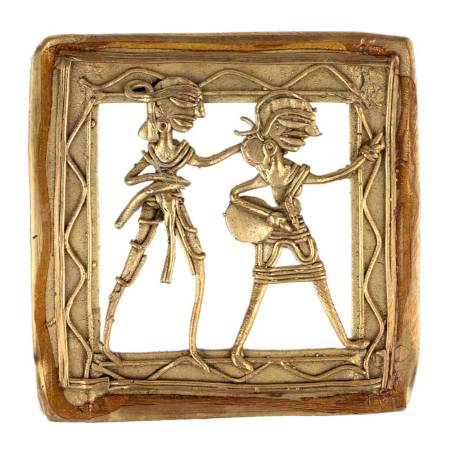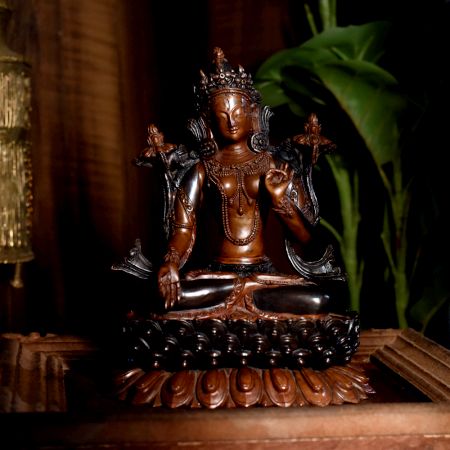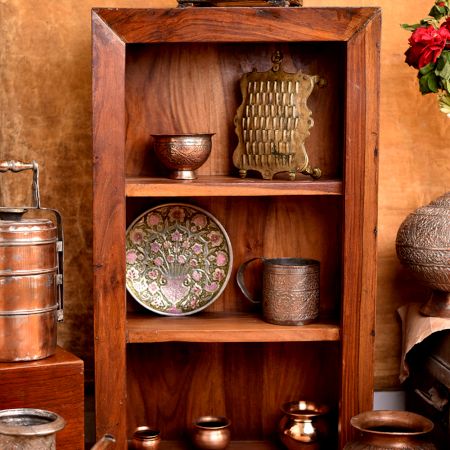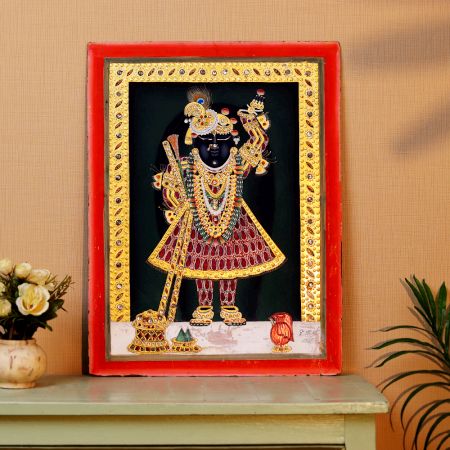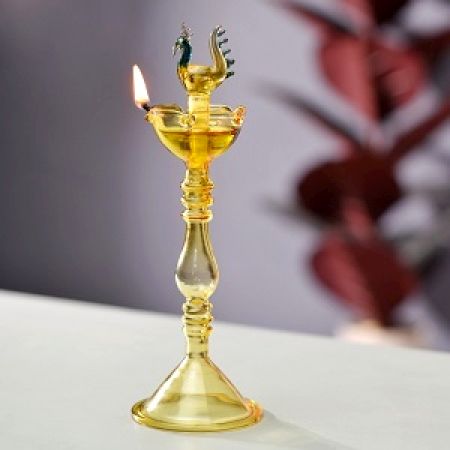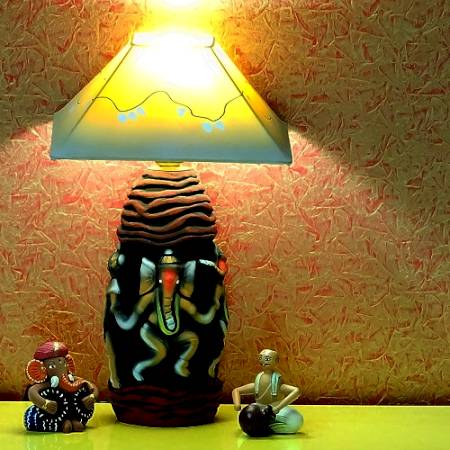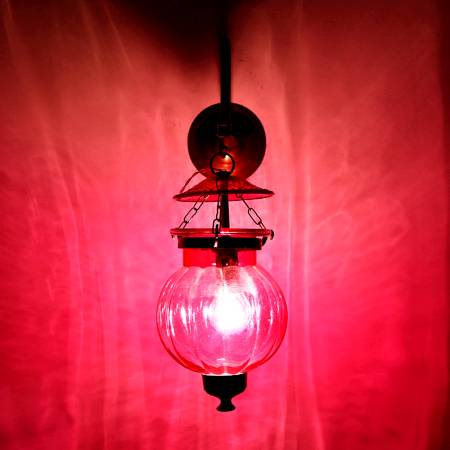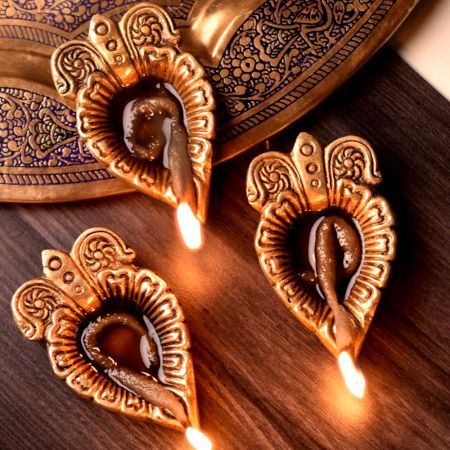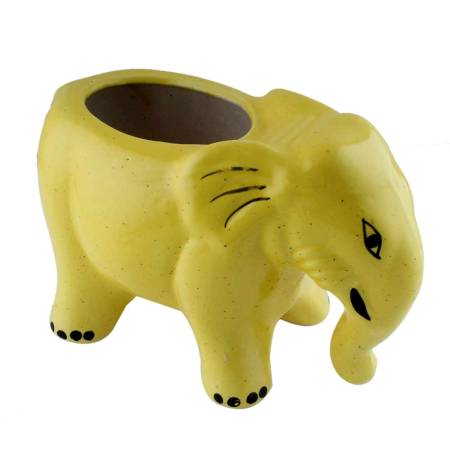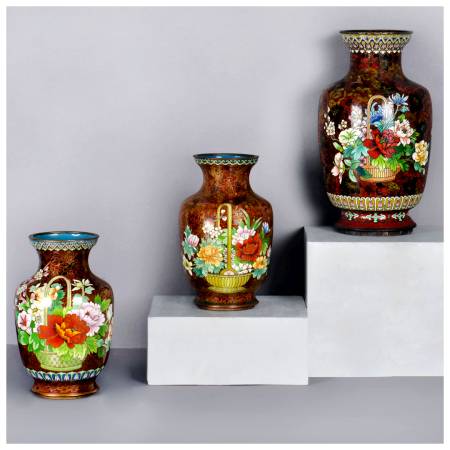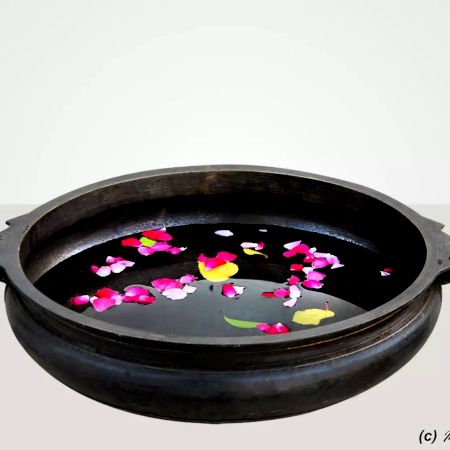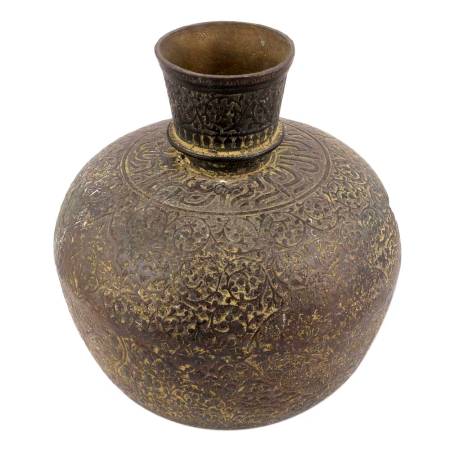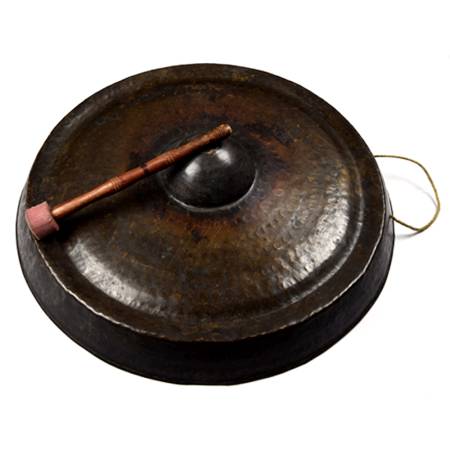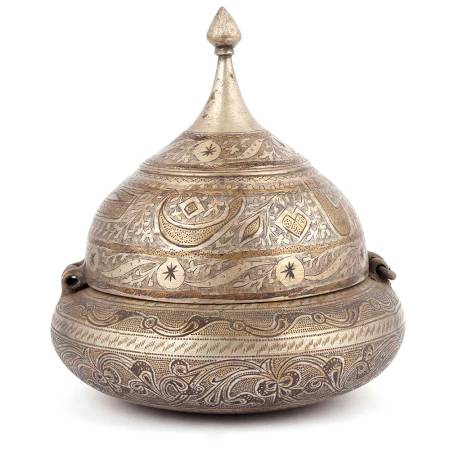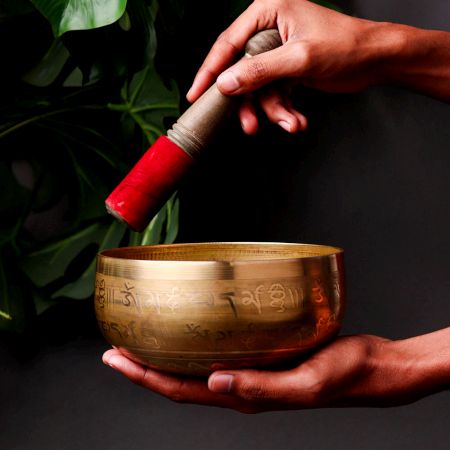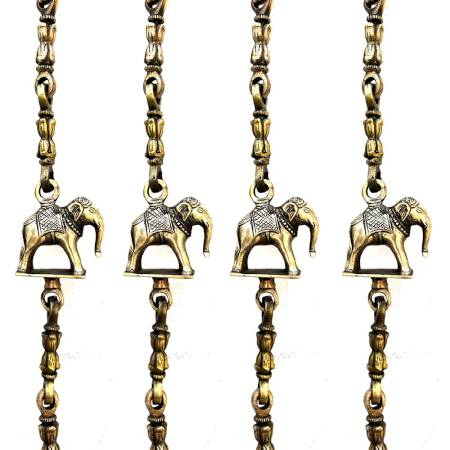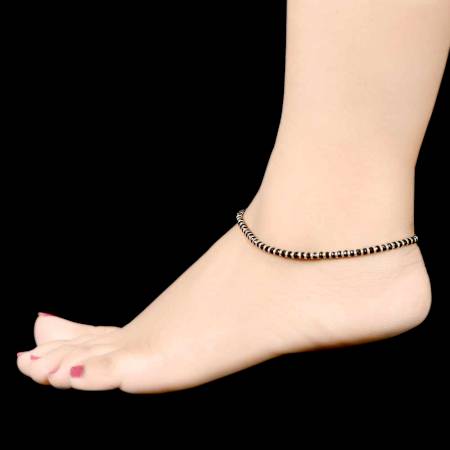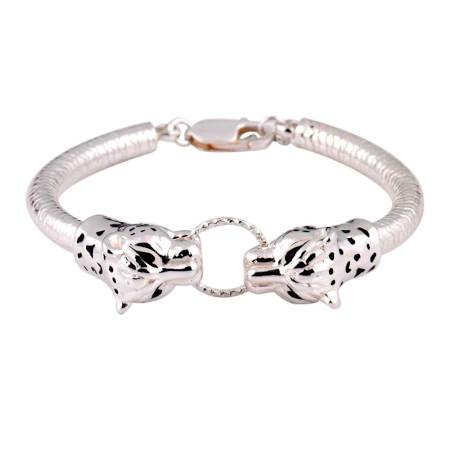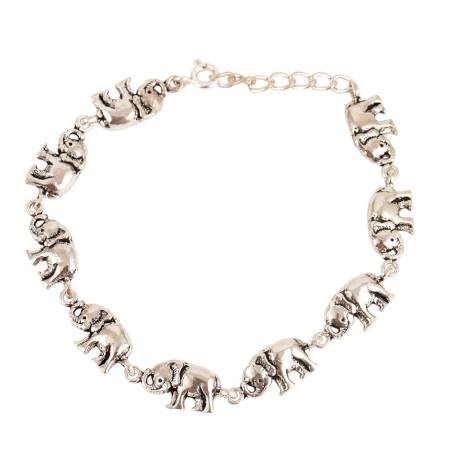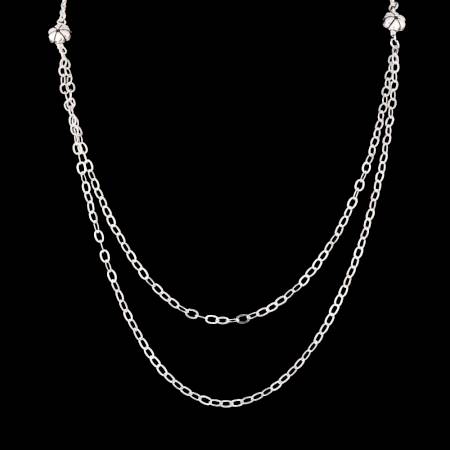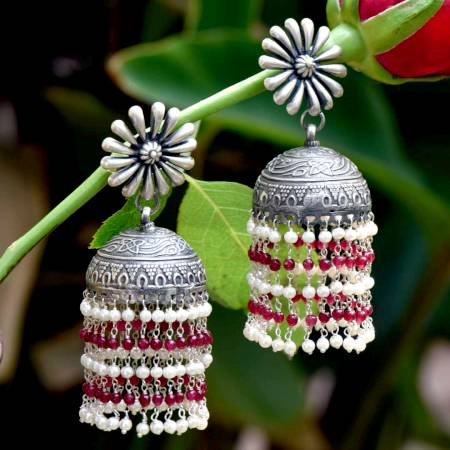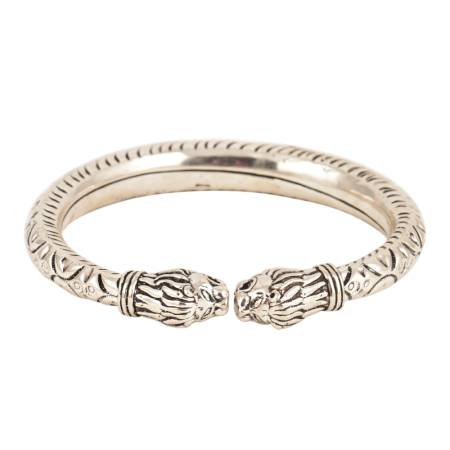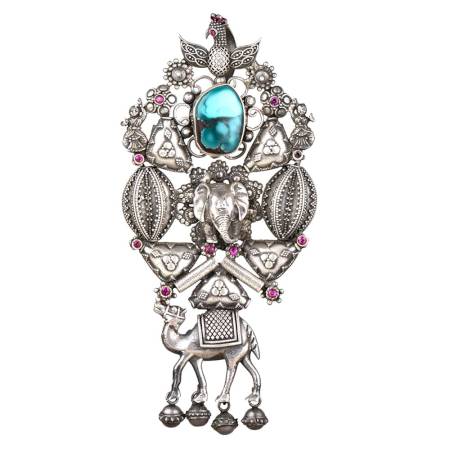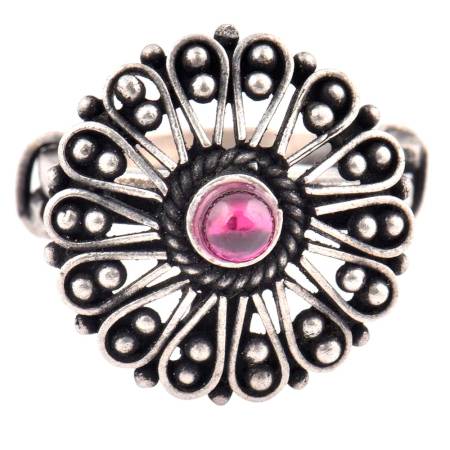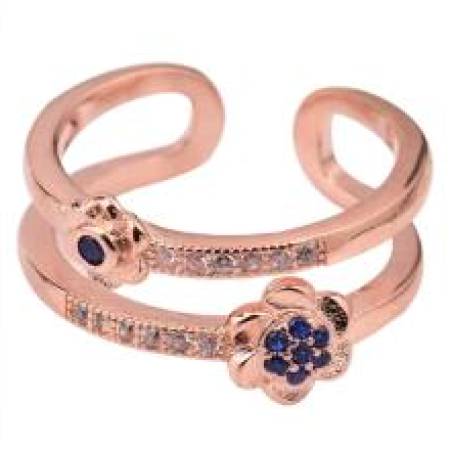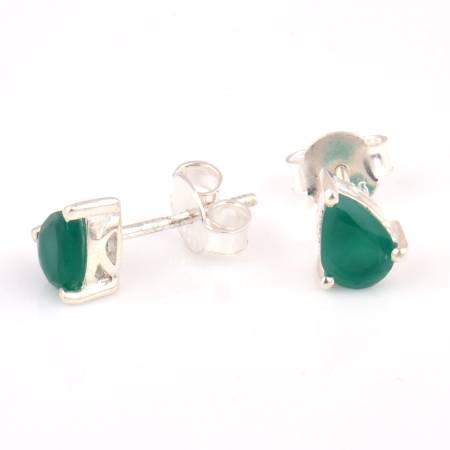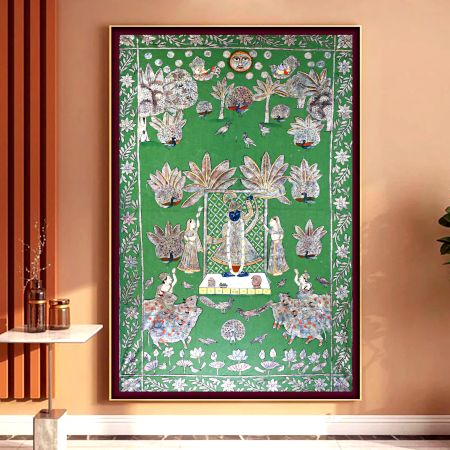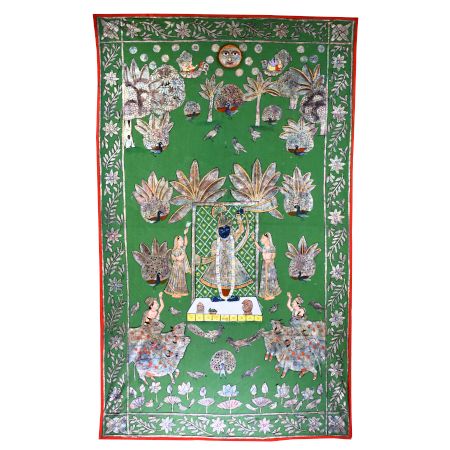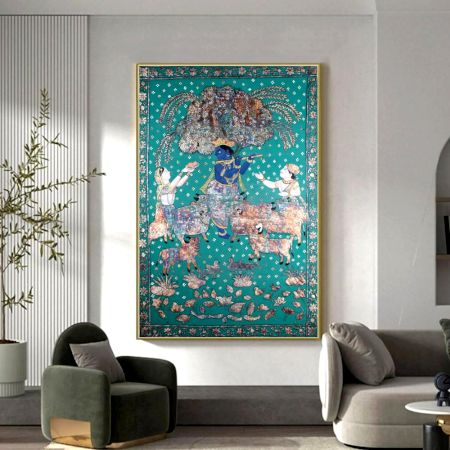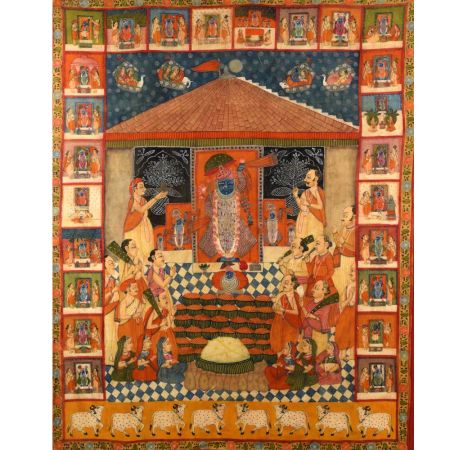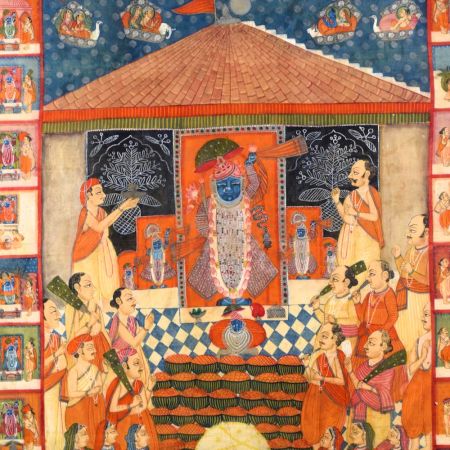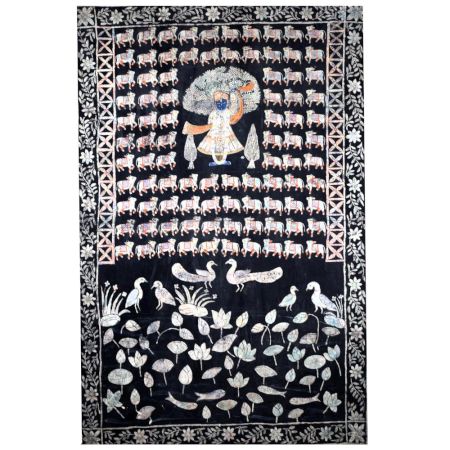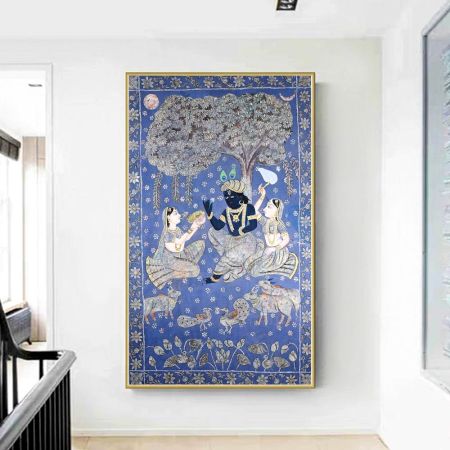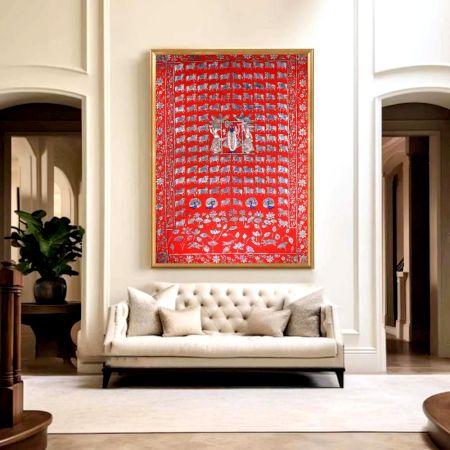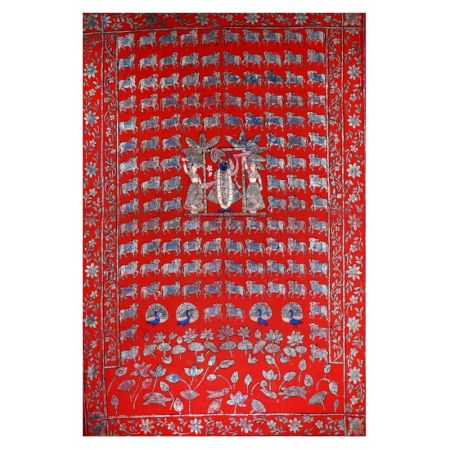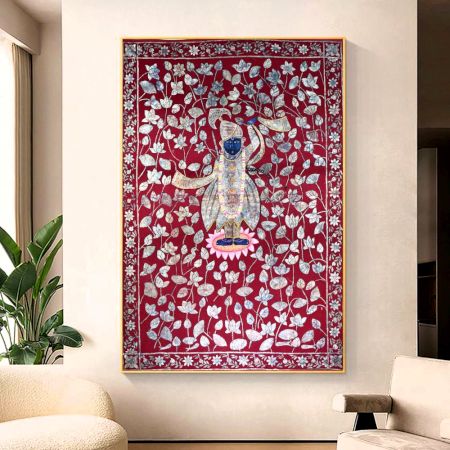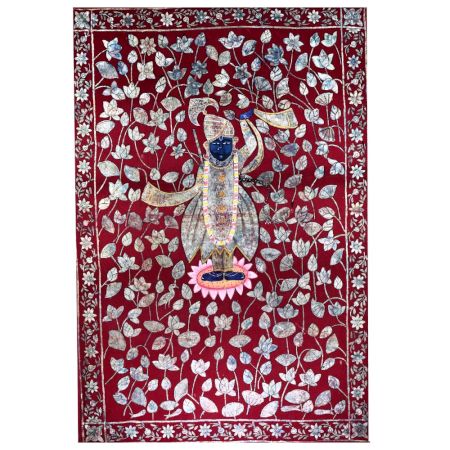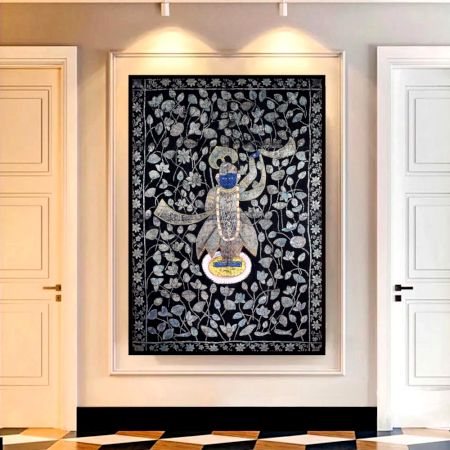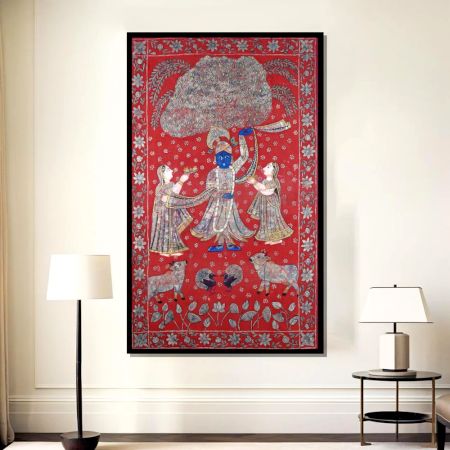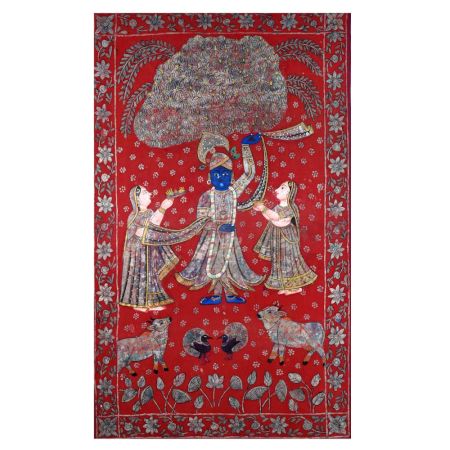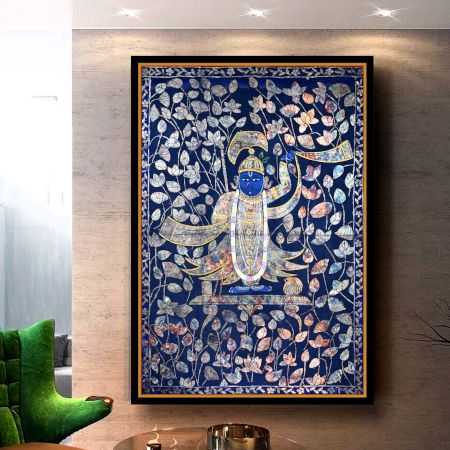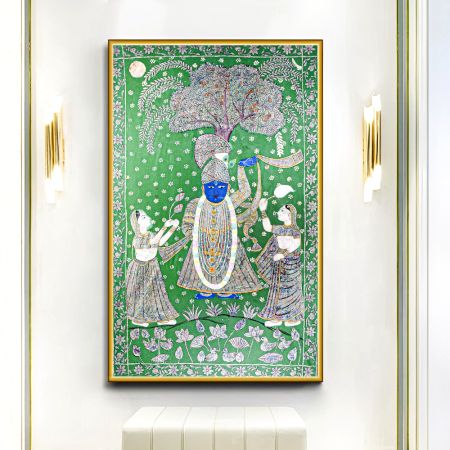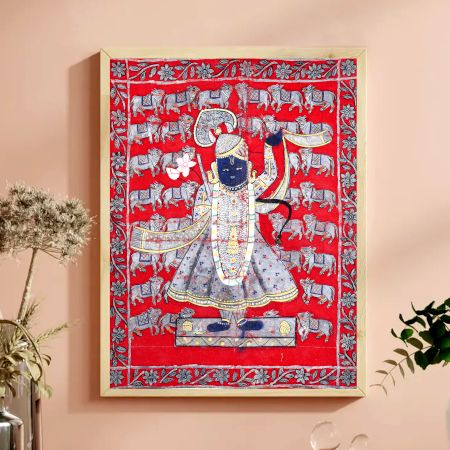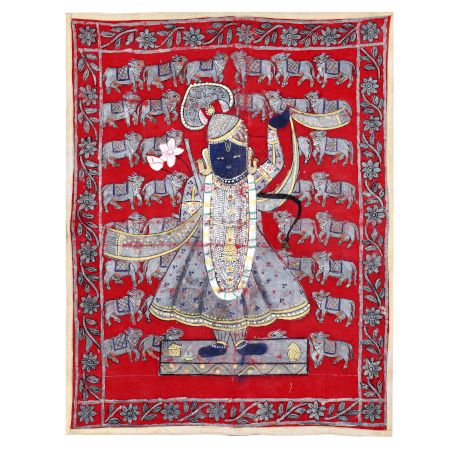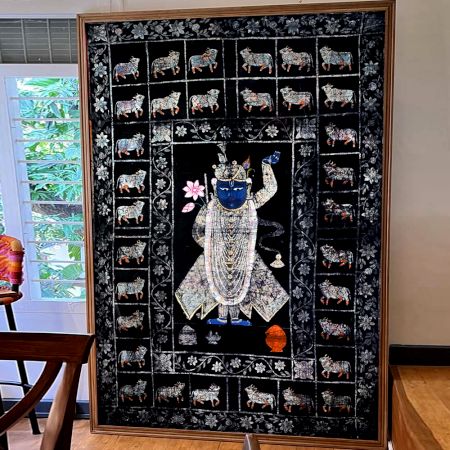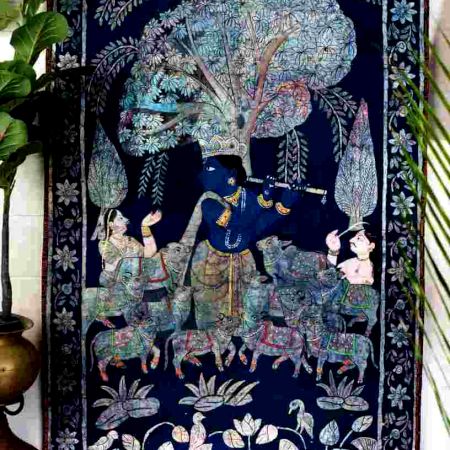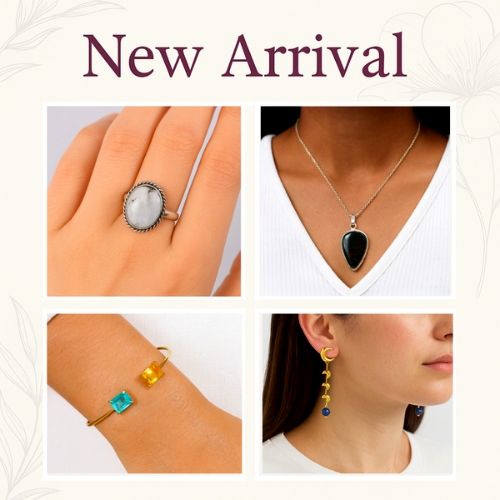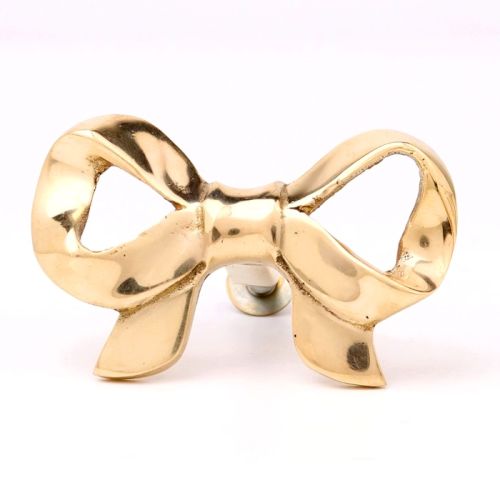-
Vintage Cloth Pichwai Painting of Lord Krishna in Golconda Art for Prayer Room
- ₹ 48,000.00
-
Only 1 left
-
Hand Painted Lord Krishna Golconda Art Cloth Pichwai Painting for Decoration
- ₹ 45,000.00
-
Only 1 left
-
Watercolor Miniature Painting Of Princess Royal Obsessed With Portraying Her King
- ₹ 54,300.00
-
Only 1 left
Buy Original Shrinathji Pichwai Paintings Online
General Understanding of Pichwai Paintings
Pichwai paintings are more than decorative masterpieces—they are visual hymns woven on cloth, primarily dedicated to Lord Shrinathji, a form of Krishna. Rooted in Nathdwara, Rajasthan, these artworks serve dual roles: as devotional backdrops in temples and as intricate records of Vaishnav traditions. Pichwai, meaning “that which hangs at the back,” blends narrative iconography with ornamental intricacies, capturing divine leelas in seasonal rhythms. Traditionally hand-painted using natural colors and gold leaf, their textures often mirror the spiritual tapestry of Indian devotion. Today, they remain timeless, bridging the ornate spirituality of past centuries with a quiet, contemplative relevance in modern spaces.
What Is A Vintage Painting In The Context Of Pichwai?
A vintage painting in the context of Pichwai is one that encapsulates the stylistic, material, and devotional essence of its origin period—typically 17th to early 20th century Nathdwara. Such paintings are not merely old; they embody a patina of ritual wear, historical dyes, and handwoven cloth that modern reproductions often lack. A vintage Pichwai painting carries signs of temple use—fold creases, faded vegetal pigments, and occasional silver or gold gilding. These aspects are not flaws but hallmarks of age and sanctity. It’s a tactile memory of time and devotion, where each brushstroke carries an artisan’s surrender to the divine. These artworks reflect not only artistic mastery but also a specific socio-religious context—one of rituals, seasons, and temple architecture. In essence, a vintage Pichwai is a spiritual document, a rare intersection of heritage, artistry, and transcendental storytelling that continues to echo centuries later on cloth still breathing with purpose.
What Emotions Or Themes Do Pichwai Paintings Commonly Portray?
Pichwai paintings articulate a spectrum of emotions—bhakti (devotion), shringar (divine love), vatsalya (motherly affection), and leela (playfulness). At their core lies Krishna’s enigmatic presence, surrounded by gopis, cows, lotuses, and celestial motifs. Each Pichwai scene is seasonally and spiritually attuned—Sharad Purnima glows with romance under a moonlit hue, while Annakut captures festive abundance. Thematically, they celebrate the cyclical rhythm of devotion through festivals, rituals, and nature. The emotional undercurrent is devotional intimacy—God not as a distant entity but as a child, a lover, a cosmic playmate. Even in their stillness, Pichwais evoke motion: fluttering peacock feathers, flowing Yamuna, and rhythmic rituals in temple corridors. These compositions, dense yet precise, blend ornamental symmetry with soulful storytelling. Pichwai doesn’t merely depict—it invokes. Each element, from intricate lotus patterns to rhythmic cow processions, forms a visual mantra that leads the viewer inward—toward contemplation, surrender, and timeless rasa.
What Are The Most Recognized Styles In Pichwai Art?
Pichwai art manifests in several celebrated styles, each echoing the regional, seasonal, and spiritual fabric of its time. The Nathdwara School remains the most iconic, known for its symmetrical compositions and Shrinathji-centered layouts. Then there's the Kota-Bundi influence, where Mughal aesthetics weave into Rajasthani folk ethos—resulting in softer brushwork and delicate natural elements. The Kishangarh style, known for elongated eyes and ethereal grace, occasionally filters into Pichwai's visual grammar. Monochrome Pichwais—often in indigo or sepia—highlight meditative minimalism, contrasting the opulence of gold-leafed festival scenes. Floral borders, intricate jharokhas (arched windows), and richly adorned garments form structural cues. Artists also distinguish between daily darshan scenes and specific festive panels—each with its design logic and chromatic palette. Stylistically, the art balances devotional realism with ornamental abstraction. Today’s revivals explore these styles through contemporary mediums—like silk-screen printing and metallic embroidery—yet traditional hand-painted Pichwais continue to dominate as the most revered aesthetic signature.
Why Are Pichwai Paintings Still Revered In The Contemporary Art World?
Pichwai paintings resonate deeply in the contemporary art world because they offer more than visual allure—they provide narrative architecture, spiritual intimacy, and artisanal integrity. As global audiences rediscover the allure of slow art, Pichwai’s intricate handcrafting, natural pigments, and symbolic density stand in poetic opposition to digital immediacy. Their continued reverence lies in their duality: both sacred relic and modern aesthetic. They fit within luxury décor yet retain ritual gravity. Contemporary collectors, curators, and interior stylists gravitate toward Pichwai for its storied past and its graphic boldness—symmetry, repetition, and vibrant iconography all lend it modernist appeal. Furthermore, their spiritual symbolism transcends boundaries, attracting not just Vaishnav devotees but seekers of cultural heritage and philosophical depth. They are no longer just backdrops for shrines; they have become meditative canvases in galleries, homes, and museums. In preserving the divine through brush and cloth, Pichwai continues to whisper eternity into the ears of the present.
Techniques, Mediums & Artistic Tools for Pichwai Paintings
Pichwai paintings—sacred, intricate, and devotion-driven—aren’t mere visuals; they’re an evocative homage woven into fabric, temple walls, and spiritual memory. Rooted in Nathdwara, Rajasthan, these artworks are often rich with minute brushwork, symbolic iconography, and elevated storytelling through colors. Artists use handmade brushes crafted from squirrel hair, employing slow, deliberate strokes that echo discipline and bhakti. Layering techniques are applied for depth—starting with sketching outlines in charcoal or fine ink, then building up with mineral pigments. Gold leaf detailing and natural stone-based colors add luminosity. Pichwai’s technique is ritualistic—almost meditative—bringing Krishna’s leelas alive in ornate precision.
How Were Traditional Pichwai Paintings Created?
Traditional Pichwai paintings were not spontaneously painted but painstakingly planned and executed in phases. First, the artist began with a rough outline using charcoal or diluted ink, sketching Lord Krishna—often in his Shrinathji form—surrounded by cows, gopis, lotuses, or festival motifs. The lines were then refined with fine brushes. Artists used crushed minerals, semi-precious stones, and organic substances like indigo, saffron, and lapis lazuli to formulate pigments. The color application was layered—backgrounds were filled first, followed by figures, ornaments, and detailing. Gold and silver leaf would be added at the end to highlight divine features or sacred symbols. These paintings were collaborative—masters supervised, while apprentices handled secondary elements. A final varnish made from organic gum was applied to protect the work. This process could take several weeks to months, depending on the complexity, making each Pichwai not just a painting, but a spiritual labor of love and time.
What Painting Mediums Were Commonly Used In Pichwai Eras?
Pichwai painting mediums were deeply tied to nature and religious purity. Artists avoided synthetic materials and relied on earth-derived or temple-sanctioned resources. Natural stone pigments such as azurite (for blue), verdigris (for green), cinnabar (for red), and charcoal (for black) were staples. Cow urine and neem resin were sometimes used for binding or antimicrobial layering. The spiritual sanctity of the medium was crucial—colors were crushed and mixed with gum arabic, goat milk, or tamarind seed paste for texture and longevity. Even gold was hand-hammered into foils and delicately pressed on. Brushes were handmade from animal hair—often from calves or squirrels—to ensure precision in miniatures and ornamentation. The conscious use of natural mediums wasn’t merely aesthetic—it reflected a cosmic order, one that honored both nature and divinity. In every stroke, the medium served not just form, but ritual.
What Role Did Canvas, Wood, Or Fabric Play In Pichwai Art?
The base material—be it fabric, wood, or canvas—wasn’t passive; it shaped the very mood and durability of the Pichwai. Traditionally, hand-woven cotton fabric was the most revered surface, symbolizing purity and accessibility for temple decor. The fabric was soaked, starched with rice paste, and sun-dried before painting to create a taut, absorbent surface. In some royal commissions or portable works, wood panels were used, often prepared with layers of chalk and adhesive to mimic a fresco texture. Canvas—more modern—was introduced later, but remained rare in temple settings. Each material demanded different brushwork rhythms—fabric absorbed more, allowing subtle blending, while wood and canvas demanded bolder, faster strokes. Moreover, the material decided the artwork’s function: wall-hung festival Pichwais used cloth, while narrative panels or collectibles used wooden boards. Every material held a ceremonial significance—transforming mere art into a medium of devotion and architectural presence.
Artistic Intent and Visual Storytelling of Pichwai Paintings
Pichwai paintings are not just visual renditions; they are immersive scrolls of divinity told through intricate brushstrokes. The artistic intent lies in celebrating the eternal presence of Lord Shrinathji, anchoring time, devotion, and space into one framed sanctum. Every stroke is deliberate—echoing rituals, seasonal changes, festivals, and daily temple customs in Nathdwara. Storytelling is layered through symbolic cues: lotus ponds mirror spiritual purity, cows express pastoral abundance, and rich textiles signal royal opulence. Visual grammar emerges in symmetry and precision—each motif, border, and deity posture breathing rhythm into the sacred narrative. In essence, Pichwai is a prayer, painted.
What Stories Or Messages Do Pichwai Paintings Aim To Convey?
Pichwai paintings narrate episodes from the life of Lord Krishna, particularly in his Shrinathji form, with an emphasis on his childhood and pastoral exploits. These artworks don't merely recount tales—they ritualize them. Stories like Govardhan Leela, Raas Leela, or seasonal celebrations such as Sharad Purnima, Janmashtami, or Annakut are transmuted into visual liturgies. At the heart of each composition is an intention—to invoke devotion, preserve cultural memory, and mirror the vibrancy of temple rituals. Symbolism is layered: lotus flowers represent purity, peacocks echo divine beauty, and cows stand for prosperity and dharma. Often, visual hierarchies establish divine centrality—with Shrinathji towering as the fulcrum. These are not passive images; they are lived experiences painted to engage the eyes, stir the soul, and humble the intellect. The stories aren’t just told—they are performed on cloth, making Pichwai not only devotional but dramaturgical in nature.
How Do Artists Express Political, Spiritual, Or Cultural Symbols Through Pichwai Art?
Pichwai artists embed political, spiritual, and cultural symbols through a delicate interplay of motif, iconography, and color symbolism. Spiritually, the central figure of Shrinathji—often adorned with garlands and elaborate costumes—anchors the composition, asserting divine authority and devotion. Cultural elements enter through depictions of Rajasthani textiles, regional flora-fauna, and temple architecture, grounding the art in Nathdwara’s aesthetic geography. Politically, Pichwai once signified regional pride and temple-centric autonomy, especially under Mewar patronage. The grandeur of processions and imperial-scale landscapes reflect a subtle assertion of cultural sovereignty. Hierarchies of power are coded—divinity central, humans peripheral. Gold leaf, indigo, and natural pigments serve not just as material but metaphor—royalty, eternity, and sacredness, respectively. Artists rarely sign their works, allowing the deity to remain the focus—removing ego to elevate bhakti. The art becomes a sacred language, a pictorial manuscript that speaks of power, purity, and permanence, hidden behind ritualistic elegance.
How Do Light, Shadow, And Color Palettes Influence The Mood Of Pichwai Paintings?
In Pichwai, light and shadow are not just optical techniques—they are emotional cues. The mood is choreographed through deliberate color theory and tonal layering. A morning darshan scene glows with pale saffrons, ivory whites, and rose pinks, invoking serenity and freshness. Conversely, night-themed compositions such as Sharad Purnima shimmer with indigo blues, silver moonlight glints, and deep velvety shadows, evoking intimacy, mysticism, and transcendence. Shadows are used sparingly, often symbolic rather than literal, suggesting divine presence rather than absence. Color palettes echo the Raga-Ragini system—responding to seasons, times of day, and emotional tone. The brilliance of emerald greens during monsoon compositions or fiery oranges for Holi festivities doesn’t merely decorate—they narrate mood, reinforce ritual calendar, and guide the viewer's internal rhythm. Textures created through layering—often using natural dyes and gold foil—add both depth and ritual value. In essence, Pichwai’s mood is not painted—it is orchestrated like a visual raga.
Purchase, Collection & Investment of Pichwai Paintings
Pichwai paintings are more than decorative pieces—they are devotional legacies rendered on cloth with intricate symbolism and storytelling. Purchasing one isn't just about visual appeal; it’s a doorway into Nathdwara's sacred art tradition. For the discerning collector, every motif, cow, lotus, and deity becomes part of a larger visual raga. Whether you’re drawn by the rustic spiritual palette or the painstaking brushwork, acquiring a Pichwai is like inheriting a piece of temple wall—dense with myth and majesty. But as with any fine art, provenance, technique, pigment origin, and signature stylistic clues are key to distinguishing art from artifice.
Where Can You Buy Authentic Pichwai Paintings?
You can find authentic Pichwai paintings in traditional art galleries, reputable online art marketplaces, and artisan hubs like Nathdwara and Udaipur, where lineage artists still paint under age-old traditions. Look for galleries that specialize in heritage arts or government-certified emporiums that ensure the artist's origin and medium. Art fairs such as India Art Fair or Kala Ghoda Arts Festival also host curated stalls with authentic pieces. Online, platforms like IndianShelf, Artisera, The India Craft House, and even Saffronart auction listings occasionally feature genuine Pichwais. Yet, physical interaction with the artwork—touching the starched cloth, observing the tactile layers of natural pigment, and speaking to the artists—is ideal. Meeting artists or workshops through artisan communities or residencies ensures both authenticity and storytelling, enriching your understanding beyond ownership.
How Can You Verify The Authenticity Of A Pichwai Painting?
Authenticity in Pichwai lies not just in visuals but in technique, material, and lineage. Traditional Pichwai is painted on starched cotton or hand-pressed paper using natural pigments like gold, indigo, saffron, and lapis lazuli. The iconography—Shreenathji’s posture, cow motifs, gopis, lotuses—follows a codified grammar rooted in temple tradition. Start by verifying the medium: real Pichwai feels textured, not printed. Study the pigment layering—genuine works exhibit dimensional build-up rather than flat color blocks. Brushwork is deliberate, not digitally symmetrical. Reputable artists often sign or watermark their works subtly in corners or along borders. Provenance documents, awards, or artisan affiliations (like with Nathdwara temples) enhance credibility. And most importantly, consult curators or art historians who specialize in religious Indian miniature traditions—because true authenticity is as much historical alignment as material accuracy.
What Makes A Pichwai Painting A Worthwhile Investment?
A Pichwai painting is an aesthetic heirloom and a cultural asset. Its value lies in heritage, technique, and the slow extinction of traditional hand-painting practices. Each work, especially those by legacy families from Nathdwara, is time-intensive—often taking weeks to complete with layers of natural pigments, gold leaf, and ornate brush detailing. Its thematic richness—celebrating festivals like Sharad Purnima or Govardhan Puja—makes it spiritually resonant, increasing its desirability among collectors of devotional art. As contemporary galleries and museums across the world display these as fine art, their financial value escalates. Scarcity, artist recognition, and age add exponential worth. For collectors, it functions like investing in a historical manuscript—visually beautiful, culturally dense, and increasingly rare. With rising global interest in regional Indian art, acquiring a certified Pichwai today could be tomorrow’s masterpiece in a climate-controlled gallery.
Care, Framing & Preservation of Pichwai Paintings
Pichwai paintings are not merely artworks—they are living narratives steeped in devotion, time, and temple rituals. Preserving them is preserving heritage. Their delicate nature demands intentional care—shielding them from urban pollutants, harsh light, and excess humidity. These paintings, born on cloth or handmade paper using natural pigments, require breathing space. Rolling them with acid-free butter paper, storing them flat in archival boxes, or mounting under UV-protected glass frames are basic yet sacred practices. Avoid direct contact with hands; oils from skin can dull the vibrancy. Rotate display frequency—let them rest in darkness periodically. Pichwais carry the breath of tradition; mishandling is sacrilege.
How Do You Properly Store And Maintain A Pichwai Painting?
To store a Pichwai painting properly, one must understand its soul—crafted with natural dyes, cow dung-treated cloth, and hand-ground pigments, it’s extremely sensitive to light, temperature, and human touch. Always store it in a cool, dry place, away from direct sunlight and fluctuating humidity. The ideal method is flat storage in archival-quality acid-free boxes. If rolled, ensure a protective layer of acid-free tissue or butter paper to avoid pigment transfer or creasing. Never fold a Pichwai—creases can permanently crack the surface. During handling, cotton gloves are recommended. Avoid storing near kitchens or bathrooms, as airborne oils and moisture can damage both the pigment and fabric. Periodically unroll or unfold stored Pichwais to allow air circulation and inspect for fungal activity or insect infestation. For displayed pieces, use UV-filtering glass and climate control, especially in regions with extreme summers or monsoons. Maintenance isn’t just technical—it’s devotional. Care becomes a form of reverence.
What Frames And Materials Best Complement The Pichwai Aesthetic?
Framing a Pichwai is as much about visual harmony as it is about ethical preservation. The artwork’s ornate intricacy, typically featuring Shrinathji, lotuses, cows, and temple motifs, requires a frame that does not compete—but uplifts. Opt for solid wood frames with matte antique finishes—teak, walnut, or seasoned rosewood. Avoid glitzy, modern gloss. Instead, let raw textures speak—a muted gold beading or a subtle brass inlay enhances the regal sanctity of the painting without overwhelming it. Mount the Pichwai on acid-free linen board to allow breathability. Use museum-grade UV-protective glass to shield the pigments from fading. Avoid plexiglass; it can create static and attract dust or cloth fibers. Float framing with shadow gaps adds dimension, allowing the painting’s edges to breathe visually and physically. The frame should feel like an extension of Nathdwara’s sacred hush—quiet, timeless, dignified. It should never imprison the art, only honor it.
Can Old Pichwais Be Restored Without Losing Their Original Feel?
Yes—but only with restraint, reverence, and expertise rooted in tradition. Restoration of a vintage Pichwai is not a repainting job—it’s an act of revival. Many older Pichwais, particularly temple-worn pieces, carry scars: tears, pigment loss, moisture blotches, or mold. The aim is not to ‘repair’ these completely, but to stabilize them without altering the visual history. Traditional conservators use indigenous techniques—natural pigments, vegetable binders, and fabric patching consistent with the original weave. Every intervention must be reversible. Digital or chemical retouching is often discouraged; it can erase the soul of the piece. Instead, ethical restoration involves pigment consolidation, mild cleaning using neem-based solutions, and edge reinforcement using old cotton or mulmul cloth. The faded parts are left to whisper their own stories. Imperfection, in this context, is sacred. Restoration should feel invisible—like mending an heirloom shawl without erasing the warmth of its wear.
What Are Common Damages Pichwai Paintings Suffer Over Time?
Over the years, Pichwai paintings fall prey to a spectrum of slow, silent deteriorations. The most common is pigment fading due to prolonged exposure to sunlight or artificial lighting. Natural dyes—such as indigo, lamp black, or stone-ground yellows—begin to dull when not protected under UV-safe glass. Humidity invites mold and fungal spots, especially when stored in unventilated spaces. The fabric backing may also become brittle or warp, leading to creases and eventual tearing. Insect infestations—silverfish and termites—can nibble through layers, particularly if the painting has been mounted on untreated wood. Atmospheric pollutants (like smoke, incense soot, or kitchen vapors) cling to the surface and slowly stain or corrode the detailing. In some cases, poor restoration practices or cheap framing materials introduce acidity into the painting’s environment, accelerating degradation. Every scratch, stain, or smudge tells a tale—not just of time but of how respectfully (or carelessly) the art has been kept.
Home Decor, Styling & Mood Setting With Pichwai Paintings
Pichwai paintings are not just art—they're portals. Rooted in devotion, their strokes breathe spiritual resonance and ritualistic symbolism into modern interiors. With deep reds, serene indigos, and molten golds, these artworks don’t just decorate walls—they transform the emotional architecture of a room. From the delicate lotus motifs to the ornate depictions of Lord Krishna, every brushstroke hums with cultural rhythm and mythic memory. In contemporary decor, Pichwai doesn’t conform; it commands attention. It adds narrative weight to minimalistic rooms and elevates opulence in regal spaces. Styling with Pichwai is not about balance—it's about bold storytelling through pigment and prayer.
How Can Pichwai Paintings Influence A Room’s Ambience Or Tone?
Pichwai paintings act as emotional conductors within a space. Their vibrant hues—particularly saffron, indigo, emerald, and vermilion—evoke energies rooted in Indian aesthetics: joy, tranquility, devotion, and prosperity. A painting depicting Shrinathji against a floral backdrop doesn't just decorate a wall; it invokes sanctity and celebration. In a dimly lit room, it radiates warmth; in a bright space, it enhances clarity. The intricate storytelling, often involving cows, lotuses, and temple rituals, introduces a narrative cadence to the room, grounding it in cultural memory. Whether you're curating a meditative corner or an opulent salon, a Pichwai alters the emotional temperature. It creates stillness in chaos and depth in simplicity. The overall impact? A subtle yet profound atmospheric shift—where silence feels sacred and the mundane is infused with meaning.
What Interior Styles Pair Well With Pichwai Artwork?
Pichwai artwork pairs best with interiors that either embrace heritage or crave contrast. In traditional Indian interiors—think carved wood, brass accents, and earthy palettes—Pichwai acts as an organic extension, blending devotion with design. In modern minimalist settings, it becomes a dramatic focal point. A neutral wall magnifies its detail. Scandinavian aesthetics—light oak, white walls, soft greys—gain narrative heft when interrupted by a bold Pichwai in emerald and maroon. It also flourishes in bohemian or eclectic spaces where mixed textures and global influences are celebrated. Even industrial or brutalist interiors—raw concrete, exposed brick—find softness and story through its presence. The key is contrast and intention. Wherever the space leans—toward modern austerity or antique richness—Pichwai has the ability to bridge the sacred and the stylish, anchoring rooms with historical gravitas and visual indulgence.
How Do You Choose The Right Pichwai Painting For A Living Room, Hallway, Or Study?
Selecting a Pichwai is like curating a chapter of a visual scripture—it must speak to the function and soul of the room. For living rooms, opt for large-format canvases with central deity figures or floral clusters to create a reverent, regal mood. Use gold frames or temple-style mounts to intensify grandeur. Hallways, being transitory, benefit from narrow vertical pieces—perhaps with recurring cows or lotuses—that create rhythmic movement and guide the eye. Studies demand contemplation—choose monochromatic or indigo-dominant works that soothe and inspire mental focus. Ensure the artwork’s theme resonates with your intention: is it devotional energy, pastoral calm, or ornamental richness? Lighting matters too—use warm, ambient lighting to evoke temple-like intimacy. Lastly, consider the narrative—each Pichwai tells a story. Let that story echo the energy you want your space to exude.
Cultural Impact & Historical Legacy of Pichwai Paintings
Pichwai paintings are more than just sacred visuals—they’re rhythmical scrolls of cultural memory. Rooted in Nathdwara, Rajasthan, each canvas narrates the devotion to Lord Krishna in his Shrinathji form, adorned with seasonal motifs, textile-like detailing, and an altar-like frame. Their legacy stretches beyond walls and temples, impacting performing arts, textiles, and domestic decor. Pichwais echo a lyrical balance of color theory, mythological symbolism, and traditional brushwork. Each stroke is a breath of faith, each motif a ritual in pigment. Their endurance isn't just because they’re beautiful, but because they serve as spiritual dialogues across generations and disciplines.
What Is The Historical Significance Of Pichwai Paintings Across Civilizations?
Pichwai paintings emerged from the Vallabhacharya tradition during the 17th century as an offering to Lord Shrinathji. While inherently Indian in spiritual tone, their visual language shares threads with Persian miniatures, Mughal precision, and Jain manuscript illustration. Across civilizations, these paintings signify how sacred art wasn't just ritualistic but a cultural timestamp. They acted as visual storytelling tools, preserving oral traditions through pigment, grid symmetry, and divine iconography. European scholars during colonial times saw them as "naïve art," but modern revivalists recognize their blend of narrative structure, ornate textile patterning, and devotional design as a testament to India's interdisciplinary artistic legacy.
How Did Different Cultures Contribute To The World Of Pichwai Painting?
Though born in India, Pichwai paintings reflect a synthesis of cross-cultural influences. The Mughal attention to detail seeped into the floral borders and pastoral scenes. Persian art traditions brought elegance in linear symmetry and pigment layering. Chinese silk aesthetics subtly influenced fabric textures depicted in the garments of Shrinathji and gopis. Portuguese colonial traders even introduced mineral pigments and gold leaf, enriching the medium’s tactile range. Furthermore, temple murals from South India contributed to spatial composition techniques. Thus, Pichwai is not insular—it is a stylistic mosaic, absorbing visual languages while keeping its Vaishnavite heart intact. It’s devotional, but also global in lineage.
Which Artists Shaped The Evolution Of Pichwai Art Movements?
Though early Pichwai artists remained anonymous temple painters, modern revivalists have shaped the art’s resurgence. The Nathdwara school gave rise to families of painters who passed down not only skills but ritual knowledge. Notable among contemporary names is Bhagwat Prasad Sharma, who introduced fine-line detailing and metallic hues in Pichwais. Kalyan Mal Sharma pushed the genre toward textile-inspired minimalism. In recent times, artists like Rajaram Sharma and institutions like the Sanskriti Foundation helped reposition Pichwai from temple backdrops to gallery-worthy high art. These artists didn’t just replicate tradition—they reimagined it, balancing sacred storytelling with modern aesthetics, thereby preserving its timeless spirit.
Pichwai Paintings vs Other Art Forms
Pichwai paintings are not just visual compositions; they are curated experiences of devotion, culture, and classical ornamentation. Unlike contemporary formats that often rely on deconstruction or spontaneity, Pichwai follows a sacred grammar—its symmetry, iconography, and ritualistic detailing render it both spiritual and architectural. Whether it’s the rhythmic repetition of lotuses or the poised gaze of Shrinathji, each element breathes purpose. While modern styles often explore inner chaos, Pichwai externalizes harmony. With its densely packed motifs and rich pigment layering on cloth, it doesn’t whisper ideas—it chants them. It's neither abstract nor literal. It’s ceremonial.
How Are Pichwai Paintings Different From Modern Abstract Or Minimalist Art?
Pichwai paintings and modern abstract or minimalist art operate in fundamentally different spheres of visual philosophy. Minimalist art pares down to the essence—seeking purity in voids, often monochromatic, and driven by space rather than story. Pichwai, on the other hand, is lush—ornamented with divine narrative, layered detailing, and a celebration of excess that resists reduction. Abstract art is often introspective, allowing interpretation to rest solely on the viewer. Pichwai is directive. It guides the eye through devotional symbols, telling mythic tales that must be seen in sequence. Where minimalist art breathes in silence, Pichwai sings in chorus. It is liturgical. Crafted for temple walls and rituals, its purpose is not aesthetic alone—it is emotional and transcendental. Every brushstroke serves a prayer.
What Sets Pichwai Paintings Apart From Digital Art Or Prints?
Digital art and prints, though visually compelling, lack the tactile sanctity and spiritual gravity embedded within Pichwai. Each Pichwai is handmade, often involving multiple artisans working harmoniously over weeks or months. There's a sanctified patience in every layer of gouache or natural pigment. In contrast, digital art is born from efficiency and replication—its aura often limited to screen resolution and printing technique. Pichwai’s textures are not visual illusions but physical truths—the warp and weft of cloth, the grain of hand-mixed color, the human errors that lend individuality. Digital art tends to emphasize versatility, while Pichwai treasures specificity—each painting corresponds to particular temple rituals, seasonal festivals, or cosmic moments. You can feel the time in a Pichwai painting; digital art moves with time. One is a sacred heirloom; the other, a shareable asset.
How Do Pichwai Watercolors Differ From Oil-Based Works?
Pichwai watercolors bring with them an ethereal translucency and reverence for fluid control, particularly suited to capturing divine motifs and symbolic finery. Unlike oil paints, which are heavier, more tactile, and lend themselves to volume and realism, watercolors in Pichwai are employed to elevate stylization. They allow pigment to breathe through cloth, offering luminosity rather than density. Oil works often boast realism, but Pichwai doesn’t chase realism—it amplifies idealism. Oils blend and evolve on canvas, while watercolors in Pichwai are layered with discipline, demanding precision and ritualistic sequencing. The textures of oil artworks may hold impasto and shadow, but Pichwai watercolors absorb the light, offering a radiant stillness. Water flows, and in Pichwai, it is guided—just like the traditions that birthed it. Each wash of color in a Pichwai speaks not only of craft but of cosmology.
Emotional & Symbolic Value of Pichwai Paintings
Pichwai paintings are not mere visual treats; they’re vessels of emotion, devotion, and storytelling. With every stroke of mineral pigment on fabric, they carry sanctity, nostalgia, and legacy. These artworks aren't just for aesthetic pleasure—they whisper stories of Krishna’s leelas, echo temple bells, and hold the breath of rituals once performed under oil lamps. Their symmetry and ornate detail evoke both spiritual elevation and grounded rootedness. When hung in homes, they don’t just decorate—they consecrate. They become extensions of prayer rooms, family altars, or quiet personal spaces where faith breathes. Pichwais often signify continuity—a cultural heartbeat passed down, untouched by time. In their presence, silence gains meaning, and stillness becomes expressive.
Can Pichwai Paintings Serve As Meaningful Gifts For Special Occasions?
Yes, gifting a Pichwai painting transcends the ordinary. Unlike mass-produced art or conventional presents, a Pichwai carries the weight of tradition, devotion, and artisanal care. It’s not just a gift—it’s a gesture layered with thought, aesthetic precision, and spiritual warmth. For weddings, housewarmings, anniversaries, or festivals like Janmashtami or Diwali, a Pichwai evokes reverence and cultural rootedness. It becomes an heirloom-in-the-making, especially when one chooses motifs like cows, lotuses, or Shrinathji. The act of gifting a Pichwai is poetic: it offers a piece of divine narrative wrapped in color, texture, and emotion. It reflects a giver who understands not just art, but sentiment, sanctity, and history. Each time the recipient gazes upon it, they relive the occasion, the bond, and the feeling behind the gift. In that sense, a Pichwai doesn’t just hang on a wall—it dwells in memory.
What Emotional Value Do Inherited Or Family Pichwais Hold?
Inherited Pichwais are emotional archives. They aren't just artworks; they’re woven diaries of generations. Each crack in the pigment, each faded hue, bears witness to festivals celebrated, prayers whispered, and hands that once touched them with devotion. Owning a family Pichwai means inheriting not just an object but an aura. Often passed from grandparents or elders, these paintings become visual signatures of familial identity. They preserve not only faith but also memories—of a time when rituals were elaborate, life slower, and homes centered around devotion. The fabric might age, but the sanctity intensifies. In moments of personal chaos or loss, inherited Pichwais feel like silent counsellors—anchoring, calming, sacred. To touch such a painting is to touch one’s ancestry. In a modern world that often forgets its roots, an old Pichwai reminds one of belonging.
Why Do People Feel A Deep Connection To Pichwais From Past Eras?
Pichwais from the past possess an ineffable aura—something no new canvas can replicate. Their charm lies in their imperfections, their faded golds, their time-worn reds. People feel deeply connected to these works because they carry the soul of an era—hand-ground pigments, cow dung-treated canvases, and brushes made from squirrel hair. They breathe of temple walls, holy chants, and incense trails. Viewing a vintage Pichwai is like unlocking a sacred time capsule—it resonates not just visually but viscerally. There’s a poetic sadness, a longing in such paintings that stirs the subconscious. They evoke a simpler time where devotion was ornate, and art had patience. People are drawn to that depth—to the sanctity of slowness, the reverence of craft, and the emotion of lost rituals. In a world hurtling forward, these paintings root the soul backward—in remembrance, reverence, and rhythm. That’s why they’re not just loved—they're felt.
Frequently Asked Questions (FAQs) on Pichwai Paintings
What Defines A Painting As Vintage In The Case Of Pichwai?
A Pichwai painting is considered vintage not merely by its age but by its aesthetic soul, historical continuity, and ritualistic symbolism. What qualifies it as vintage lies in its composition: natural pigments, starched fabric, mythological narration, and temple-rooted iconography that echoes devotion. Age amplifies the patina, but it is the devotion-laced storytelling—the depiction of Shrinathji with moonlit cows, lotus ponds, and celestial blue backdrops—that anchors its vintage identity. A vintage Pichwai retains wear and weathering that resemble a sacred memory preserved in brushwork—cracks that whisper temple bells, faded pigments that hold spiritual murmurs. Texture and pigment layering, done with reverent strokes, further age the piece not just physically but spiritually. The brush carries more than color—it carries ritual, and the cloth, more than imagery—it holds offering. That is what defines a vintage Pichwai: not just old, but ornamented by time and sanctified through repetition.
Can Pichwai Paintings Be Recreated Authentically Today?
Yes—but authenticity in Pichwai recreation demands more than mimicking motifs. It requires invoking the ritualistic cadence that governed the original creation. Today, while the strokes can be trained and the pigments sourced, what becomes elusive is the devotional discipline—the spiritual pause between gestures, the unspoken mantra that guides the artist’s hand. True recreation demands traditional mediums: hand-woven starched cotton, natural dyes from minerals and cow urine, and meticulous brush layering that replicates the antique textural grain. But more deeply, it requires an artist attuned to visual bhakti—someone who paints not for market, but for offering. While contemporary tools tempt convenience, an authentic recreation must honor ancient stylization—symmetry, repetition, negative space storytelling. Even if modern creators attempt it, authenticity only arrives when reverence surpasses reproduction. Thus, today’s artist must not only copy forms but embody the spiritual grammar, emotional memory, and symbolic resonance that vintage Pichwai carries like sacred breath.
How Do You Protect Pichwai Artwork From Light And Moisture Damage?
Pichwai paintings are delicate echoes of devotion and thus demand environmental reverence. Their natural dyes—derived from minerals, stones, and organic compounds—are light-sensitive and fade easily under direct exposure. The first line of protection is UV-filtering glass when framed, or avoiding sunlight entirely when displayed. Maintain ambient humidity between 45%–55% to prevent fungal growth and fabric warping. Use acid-free backings and cotton gloves during handling. For scroll-based or unfixed Pichwais, store flat in archival folders or roll with muslin interleaves to prevent pigment transfer. Moisture’s silent ruin can be prevented by silica gel pouches nearby or dehumidifiers during monsoon. Avoid chemical cleaners or sprays—dust only with a soft brush. In essence, treat the painting as ritual artefact, not decoration. The preservation must echo the sacredness it was painted with. Let light fall like reverence, and air like breath. It’s about maintaining sanctity, not just surface.
Are Pichwai Paintings Still Relevant In Modern Art Scenes?
Absolutely—Pichwai has transitioned from temple sanctum to contemporary studio without losing its cultural umbilical cord. In a world increasingly fascinated by rooted minimalism, sacred geometry, and storytelling through symbol, Pichwai offers fertile ground. Modern artists reinterpret its visual codes—flattened perspective, divine motifs, and sacred flora—within new narratives. Exhibitions now celebrate it not just as a devotional art but as a textile manuscript, a layered history painted in strokes. Designers borrow its palettes for haute couture, architects reference its motifs for spatial storytelling, and digital artists mimic its form with modern tools. Yet, at its core, the relevance lies in its emotional scaffolding—bhakti, ritual, rhythm. Even abstraction, a pillar of modernism, exists within Pichwai’s repetition of lotus, cow, and deity. The art scene values it for its heritage, yes, but more so for its compositional discipline, meditative stillness, and iconographic depth. It’s not just relevant—it’s revered, reimagined, and reincarnated.
Can Pichwai Art Styles Be Used In Contemporary Painting Practices?
Yes, and in fact, they should—not as mimicry, but as grammar. Pichwai art styles, with their codified structure, stylized flatness, and ornamental rhythm, offer a visual language that contemporary artists can translate into new idioms. The repetition of forms—cows, trees, mandalas—becomes a meditative motif even in abstracted canvases. The compartmentalization of scenes into bordered vignettes can inspire sequential storytelling in mixed media or graphic novels. Artists today extract the symbolic syntax—the cow as purity, the lotus as transcendence, Shrinathji as divine presence—and reframe it into visual poems on identity, memory, or divinity. Even digital art practices now echo Pichwai’s layered rendering in vector forms and stylized contours. But to truly use it, one must respect its origin—study its compositions, understand its purpose, and absorb its rhythm. The aim isn’t to modernize it, but to let it breathe within new canvases, retaining its sacredness while reshaping its voice.
Paintings from Indianshef: Lord Krishna Paintings | Vintage Photos | Vintage Movie Posters | Mughal Art | Radha Krishna Paintings
